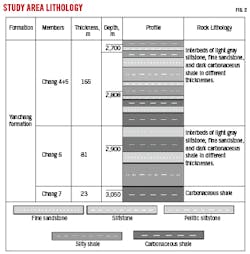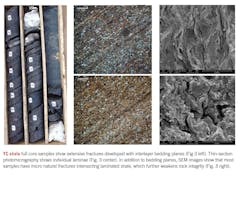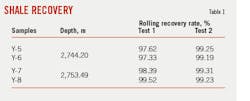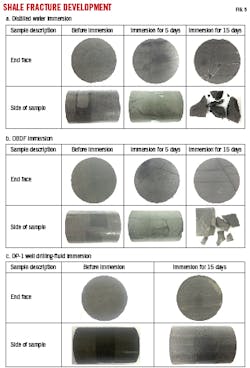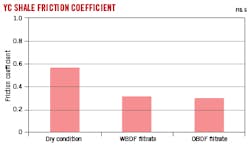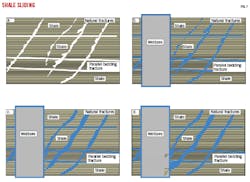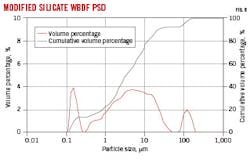Water-based drilling fluids stabilize brittle shales
Lijun You
Xiaopeng Yan
Yili Kang
Southwest Petroleum University
Chengdu, China
Considerable research has been devoted to wellbore instability in shale formations, but wellbore stability in brittle shale is still not resolved. Oil-based drilling fluids (OBDF) provide outstanding clay inhibition and rheological properties for shale drilling, but they do not solve all wellbore instability problems, have high maintenance costs, and severe environmental issues.
An optimized water-based drilling fluid (WBDF) was developed for compatibility with Triassic Yanchang YC formation shale samples in Ordos basin which represent typical brittle shales in leading shale gas exploration target zones in China. The fluid was designed to inhibit hydration and erosion and increase friction strength between shale blocks.
During field tests, fluid phase invasion was effectively controlled, and fluid rheological properties met design requirements. The drilling trip of well DP-1 using this fluid was successful without serious drilling accidents.
Brittle shale
Studies have linked shale instability to mechanical and physiochemical interactions between drilling fluids and shale formations.1 Brittle shale creates additional instability complications. It is a source rock for hydrocarbons and differs from conventional shale formations by having natural fractures from abnormally high pressures, dehydration shrinkage of clay minerals, tectonic movement, and inhomogeneous loading of the overlying strata. Fractures in the wellbore significantly increase drilling fluid invasion rate and range.
Wellbore-instability control measures based on liquid invasion into the conventional shale matrix, such as nanometer particle plugging or wettability adjustment, often fail to achieve desired results in brittle shale formations. For shale with mainly expansive clay minerals, such as smectite and illite-smectite mixed layers, hydration is the main cause of wellbore instability. However, brittle shale formations are weak-swelling, and brittle shale clay minerals are mainly illite, kaolinite, and chlorite, which are weakly expansive and weakly dispersive minerals.2 Shale hydration inhibition is therefore important for maintaining shale stability, but it is not sufficient.
OBDF were the first option to avoid borehole instability in shale formations. OBDFs provided outstanding clay inhibition, lubricity, temperature stability, tolerance to contamination, and corrosion protection.3 OBDF, however, do not completely resolve all wellbore instability problems. Field results indicate that instability problems in shale gas wells were often encountered during long horizontal sections drilled with OBDF.4 It should be noted, furthermore, that OBDF have limited applications. Special preparations and high maintenance costs, poor data acquisition, poor biodegradability, and prominent environmental issues of OBDF, especially for disposal of waste OBDF and cuttings, negatively influence economic and efficient development of shale gas reservoirs.5 Drilling horizontal wells with WBDF instead of OBDF is an urgent shale-drilling engineering problem to solve.6
Geological setting
Ordos basin is the second largest petroleum basin in China, with a total area of 250,000 sq km.7 The study area, containing experimental well DP-1, is in the western margin of the basin (Fig. 1). DP-1 is a key exploratory horizontal well targeting the YC formation, one of the leading targets for shale gas exploration and development in China.
YC shale has a higher maturity of organic matter, and its total organic content (TOC) is over 4%. The shale deposited in semi-deep and deep-lake environments, and reservoir lithology is mainly comprised of dark grey-black carbonaceous shale (Fig. 2).
YC formation shale are typical brittle shales with high content of brittle minerals (e.g., quartz) and weak-swelling clay minerals (e.g., illite). Shale samples were cored from DP-1. Mineral compositions of samples analyzed by X-ray diffraction (XRD) are dominated by clay minerals (58.35%), quartz (32.33%), feldspar (3.83%), pyrite (3.00%), and carbonatite (2.49%). Clay minerals are a mixture of illite (63.53%), interstratified illite-montmorillonite (15.74%), chlorite (12.01%), and kaolinite (8.72%).
The shale is heavily fractured and developed with interlayer bedding planes (Fig 3 left). Thin-section photomicrography shows that individual laminae in YC shale range from 0.2 mm to 2 mm in thickness (Fig. 3 center). In addition to bedding planes, most samples have micro natural fractures intersecting laminated shale, which further weakens rock integrity (Fig. 3 right).
This study exposed shale samples to OBDF and WBDF to compare relative stability of the two fluid systems. WBDF formulation consists of bentonite (2% - 4%), filtrate reducer (0.5% - 1%), tackifier (0.5% - 1%), anti-collapse agent (2% - 3%), and lubricant (2% - 3%). pH is 9.0. OBDF formulation is white oil (70% - 80%), bentonite (2%), primary emulsion (3%), co-emulsifier (3%), wetting agent (1%), oxidized asphalt (2%), micron-sized fluid loss additive (2%), CaO (4%), and barite. pH is 11.5. Filtrate was centrifuged from drilling fluids as required with a TG16-WS high-speed centrifuge.
Wellbore stability mechanisms
Water invasion forms a double-electrical layer from adsorption and aggregation of water molecules between clay layers. Hydration swelling eventually takes place as repulsive electrical forces separate clay layers. Hydration of bedding planes and micro fractures leads to increasing stress concentration at the tip of the fracture, which is a key factor for initiation and propagation of fractures. Even if expansion is small, tensile strength will be greatly reduced.
Linear expansion of YC shale samples with particle size smaller than 150 μm was measured in distilled water using a CPZ-2 dual-channel normal pressure and temperature dilatometer. Results showed that the linear expansion had a quick increase in the first 2 hr, reaching a slow, slightly increasing expansion until plateau (Fig. 4). Linear expansion ranged from 3.75% to 4.42% as shale samples soaked in distilled water for 2 hr. Rolling recovery tests showed that recovery rate is above 97%, indicating that YC is a weak-dispersed shale (Table 1). Shale hydration inhibition, however, is still important for maintaining shale stability.
Traditional laboratory methods such as swelling test and dispersion test cannot fully reflect the impacts of shale structure on fracture propagation. Immersion tests directly observe rock-fluid interactions and fracture development and provide a basis for drilling fluids system optimization.8 Shale samples with no obvious fractures were selected for distilled water immersion tests (Fig. 5a). After samples were soaked in distilled water for 5 days, several microfractures along the bedding planes were observed on the surface, and microfractures intersecting bedding planes were also observed, which made the shale more fragmented. The density and length of fractures were positively correlated with immersion time.
Alkaline erosion
In addition to fracture initiation and propagation by clay mineral hydration, alkaline rock reaction is essential for fracture development. YC brittle shale contains a high percentage of silicate minerals, such as quartz, feldspar, illite, kaolinite and chlorite, which may be dissolved in a high pH environment.9 Drilling fluid is alkaline and alkali agent is usually added in the drilling process to maintain stability of the drilling fluid system. OBDF pH, for example, mostly ranges from 10 to 12. Silicate rock-forming minerals were easily eroded by high-alkaline fluids due to the higher specific surface area of these minerals and relatively active physicochemical properties. Fig. 5b shows fracture development of shale exposed to high-alkaline OBDF at 90° C. Like fracture development in distilled water, the shale was destroyed after soaking in highly alkaline OBDF filtrate.
Mechanical experiments on shale samples before and after drilling fluid immersion were carried out with an RTR-1000 static-dynamic state triaxial-servo rock mechanics testing system. Shale plugs were drilled from core samples along bedding planes. Triaxial compression tests were performed on plugs to measure deformation and strength before the samples failed. Confining pressure was 40 megaPascals (MPa).
Compressive strength of a shale sample under dry condition was 64.7 MPa. After soaking the sample in WBDF filtrate for 15 days, the compressive strength showed a 19.9% decrease to 51.8 MPa. A similar procedure in high-alkaline OBDF filtrate reduced compressive strength to 40.3 MPa, a 37.4% decline (Table 2).
Friction-strength reduction
Friction strength between shale surfaces plays an important role in maintaining stability of fractured rock, and frictional sliding along weak joints is the main failure mechanism. Friction coefficient between shale blocks with polished surfaces was measured using the COF-1 friction coefficient system. Fig. 6 shows friction coefficient of YC shale in dry, WBDF, and OBDF filtrate conditions. Friction coefficient decreased with invasion of drilling fluid filtrate. OBDF filtrate reduced the friction coefficient by 47.3% as compared with dry condition, and WBDF reduced the coefficient by 43.8% versus dry.
Sliding between shale blocks is likely to occur when drilling fluids with strong lubricity and erosion ability invade into weak planes (Fig. 7). Friction strength reduction between shale blocks can be explained by: 10 11
- Drilling-fluid lubrication.
- Reduction of normal stresses applied to fracture surfaces by drilling fluid invasion.
- Asperities strength-reduction and fracture-surface planarization caused by fluid and rock interaction.
- Shale-blocks stress disturbance caused by wellbore pressure fluctuations.
Brittle shale is mix-wet due to the presence of organic matter and clay minerals, and both oil-based and water-based fluids can be absorbed into shale pores and fracture surfaces under high capillary force and underbalanced pressure. Brittle shale exhibits relatively high chemical activity resulting from high specific surface area of fine rock-forming minerals. The existence of fractures in the wellbore can greatly decrease rock integrity and wellbore pressure containment, which will decrease shale structural stability and increase drilling fluid invasion rate and range. Long soaking times and high wellbore pressures of shale wells will further exacerbate invasion of drilling fluids. Three main potential wellbore instability factors for YC shale are:
- Large-volume drilling fluid invasion into shale matrix and fractures.
- Strong fluid-shale reaction.
- Shale-block slide.
Invasion of drilling fluids is a precondition for shale instability. Drilling fluids invade into shale formations with nanoscale pore throats, microns-scale natural fractures, and hundred microns-scale induced fractures. Effectively plugging multiscale fluids invasion channels becomes a key job to prevent wellbore instability.
Shale hydration causes wellbore instability but enhancing drilling fluid inhibition often fails to effectively control the instability. Engineers usually increase drilling fluid density to prevent collapse, but fracture networks are difficult to plug due to developed natural and induced fracture systems. Increasing density of drilling fluids therefore increases drilling fluid invasion and increases the depth and intensity of alkali-shale reaction, triggering shale-block friction slide.
Test well, optimized fluid
DP-1 rock lithology of the second interval is a mainly long section of dark grey-black carbonaceous shale. Designed depth (2,100 m) in the straight well section of the second interval of the well was penetrated smoothly with non-solid polymer drilling fluids. The inclined shaft of the second interval was first drilled by potassium ammonium-based polymer drilling fluids, which showed better cuttings transportation capacity in the large wellbore. Serious shale collapse, however, caused pipe sticking at 2,802 m. Drilling stopped and the wellbore was backfilled for sidetrack drilling. A poly-ammonium drilling fluid was designed and selected for the second drilling operation. Serious shale collapse occurred again when drilling the YC-7 shale. The drilling fluids were both formulated for hydration inhibition, but this method failed to achieve the desired results in YC brittle shale formations.
An optimized fluid was designed to address the three brittle-shale instability mechanisms: hydration, erosion, and shale block sliding. A silicate water-based drilling fluid was selected for hydration inhibition and nanoscale pore-throat plugging. Silicon-containing groups in silicate water-based drilling fluids exhibit good plugging performance. The hydrophobic nature of the siloxane group (Si-O-Si) allows it to weaken the strength of hydration when attached to clay minerals.12
To plug pore throats and natural fractures, the modified silicate drilling fluid had 3% nano-blocking agent and 2% emulsified asphalt agent. Effective sealing of induced fractures is equally important. If the plugging zone in natural fractures cannot form rapidly, the width of natural fractures will increase from a few microns to hundreds of microns, further complicating efforts to control lost circulation.13
Considering the dynamic apertures of fractures, rigid temporary plugging materials with different sizes were added into the silicate drilling fluids. Sized rigid-granule and elastic-particle combinations create synergistic effects to optimize fracture plugging. Large-size rigid particles form the framework in the fracture plugging zone, and elastic particles fill in pores among the rigid particles.
Laser particle-size analysis measured particle size distribution of modified drilling fluids (Fig. 8). The modified drilling fluid had a wide particle-size range with three modes ranging from < 0.4 μm to 0.4-40 μm and 60-200 μm. Both nano-micropores and micro-fractures were effectively sealed due to the proper combination of blocking agents and siloxane groups.
Changing stress-state is a popular technique for increasing friction strength in fractured formations. The effect can be achieved by plugging fractures and increasing wellbore hoop stress. Fracture plugging reduces fluid pressure in the fracture.14 Increasing hoop stress increases effective normal stress on the fracture surface, resulting in higher friction coefficients between blocks. This can be obtained by widening induced fractures with high-strength rigid plugging materials.15 As mentioned above, sized rigid temporary plugging materials were added into the silicate drilling fluids. The compressive strength of the rigid granules was 30-50 MPa compared with the 20 MPa in situ horizontal effective stress in the plugging zone.
During the field test in DP-1, fluid-phase invasion was effectively controlled with 59.6% imbibition of the original WBDF (Fig. 9). The immersion test showed few fractures on shale samples soaked in the modified drilling fluids (Fig. 5c). Field experiments showed that rheological properties of the optimized drilling fluids met design requirement. The drilling trip of well DP-1 was successful without serious drilling accidents, and the open hole horizontal length reached 557 m.
References
- Gomez, S. and He, W., “Fighting wellbore instability: customizing drilling fluids based on laboratory studies of shale-fluid interactions,” IADC/SPE Asia Pacific Drilling Technology Conference and Exhibition, Tianjin, China, Jul. 9-11, 2012.
- Kang, Y.L., Yang, B., Li, X.C., Yang, J., You, L.J., and Chen, Q., “Quantitative characterization of micro forces in shale hydration and field applications,” Petroleum Exploration and Development, Vol. 44, No. 2, July 2017, pp. 328-335.
- Ponmani, S., Nagarajan, R., Sangwai, J.S., “Effect of nanofluids of CuO and ZnO in polyethylene glycol and polyvinylpyrrolidone on the thermal, electrical, and filtration loss properties of water-based drilling fluids,” Society of Petroleum Engineers Journal, Vol. 21, No. 2, April 2016, pp. 405-415.
- Caenn, R., Darley, H.C.H., and Gray, G.R., “Composition and properties of drilling and completion fluids,” Elsevier, UK., 6th ed., 2011.
- Aramendiz, J. and Imqam, A., “Water-based drilling fluid formulation using silica and graphene nanoparticles for unconventional shale applications,” Journal of Petroleum Science Engineering, Vol. 179, August 2019, pp. 742-749.
- Xiong, F.Y., Jiang, Z.X., Chen, J.F., Wang, X.Z., Huang, Z.L., Liu, G.H., Chen, F.R., Li, Y.R., Chen, L., and Zhang, L.X., “The role of the residual bitumen in the gas storage capacity of mature lacustrine shale: A case study of the Triassic Yanchang shale, Ordos Basin, China,” Marine Petroleum Geology, Vol. 69, January 2016, pp. 205-215.
- Gholami, R., Elochukwu, H., Fakhari, N., and Sarmadivaleh, M., “A review on borehole instability in active shale formations: Interactions, mechanisms and inhibitors,” Earth-Science Reviews, Vol. 177, February 2018, pp. 2-13.
- Peng, C., Yan, J., and Feng, W., “An offshore benign WBM system can prevent hard, brittle shale instability,” Petroleum Science and Technology, Vol. 28, No. 12, June 2010, pp. 1230-1241.
- Kang, Y.L., Cheng, Q., and You, L.J., “Laboratory studies of shale fracturing behaviors with rock-drilling fluid interactions,” Journal of China University of Petroleum (Edition of Natural Sciences), Vol. 40, No. 4, 2016, pp. 45-53.
- Yan, X.P., You, L.J., Kang, Y.L., Li, X.C., Xu, C.Y., and She, J.P., “Impact of drilling fluids on friction coefficient of brittle gas shale,” International Journal of Rock Mechanics and Mining Sciences, Vol. 106, June 2018, pp. 144-152.
- You, L, Kang, Y, and Chen, Z., “Wellbore instability in shale gas wells drilled by oil-based fluids,” International Journal of Rock Mechanics and Mining Sciences, Vol. 72, December 2014, pp. 294-299.
- Israelachvili, J.N., “Intermolecular and surface forces,” Academic Press, Beijing, 2012.
- Yan, X.P., Kang, Y.L., You, L.J., Xu, C.Y., Lin, C., and Zhang, J.Y., “Drill-in fluid loss mechanisms in brittle gas shale: A case study in the Longmaxi Formation, Sichuan Basin, China,” Journal of Petroleum Science and Engineering, Vol. 174, March 2019, pp. 394-405.
- Xu, C.Y., Yan, X.P., Kang, Y.L., You, L.J., and Zhang, J.Y., “Structural failure mechanism and strengthening method of fracture plugging zone for lost circulation control in deep naturally fractured reservoir,” Petroleum Exploration and Development, Vol. 47, No. 2, April 2020, pp. 1-10.
- Aston, M.S., Alberty, M.W., McLean, M.R., Jong, H.J., and Armagost, K., “Drilling fluid for wellbore strengthening,” IADC/SPE Drilling Conference, Dallas, Mar. 2-4, 2004.
Authors
Lijun You ([email protected]) is a professor in the school of oil and natural gas engineering at Southwest Petroleum University, Chengdu, China. He serves as the deputy director of the well completion center at Southwest Petroleum University. He holds a BS (2000) in applied geophysics, an MS (2004) in petroleum geology, and a PhD (2006) in well drilling engineering from Southwest Petroleum University. He is a member of SPE.
Xiaopeng Yan ([email protected]) is a PhD candidate in the school of oil and natural gas engineering at Southwest Petroleum University. He is currently working in the faculty of engineering at the National University of Singapore as a visiting student. He holds a BS (2015) in petroleum engineering from Southwest Petroleum University. He is a member of SPE.
Yili Kang ([email protected]) is a professor in the school of oil and natural gas engineering at Southwest Petroleum University. He directs the formation damage control group at the State Key Laboratory of Oil and Gas Reservoirs Geology and Exploration. He holds a BS (1986) in petroleum geology from Daqing Petroleum Institute, an MS (1989) in petroleum geology, and PhD (1998) in drilling engineering from Southwest Petroleum University. He is a member of SPE.
